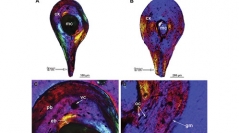

 Comptes Rendus Palevol
18 (3) - Pages 306-316
Comptes Rendus Palevol
18 (3) - Pages 306-316This paper presents histological data on the long bones of different size (age) individuals of the basal cryptobranchid salamander Eoscapherpeton asiaticum from the Upper Cretaceous (Turonian) of Uzbekistan. E . asiaticum is similar to modern members of Cryptobranchidae in being relatively large (estimated body length up to 50–60 cm), aquatic, and neotenic. The analysis of growth series of femora demonstrates a significant histological maturation during ontogeny, expressed by the progressive appearance of highly organized parallel-fibred bone in the peripheral part of the periosteal cortex, appearance and increasing number of bone remodeling features, progressive resorption of calcified cartilage in the diaphyseal areas and formation of endochondral bone lining the erosion cavities in the calcified cartilage, progressive thickening of endosteal inner circumferential layer and increasing of vascularity and appearance of vascular network of longitudinal and oblique canals in the cortex. These ontogenetic changes in the long-bone histology of E . asiaticum generally correspond to those of other salamanders, except the appearance of the vascular network in the periosteal cortex — the feature that is characteristic for cryptobranchids and connected with their large body size. According to new data, the large Cenozoic cryptobranchids appear to have attained their larger size by extending the skeletal growth period.
Caudata, Cryptobranchidae, paleohistology, gigantism